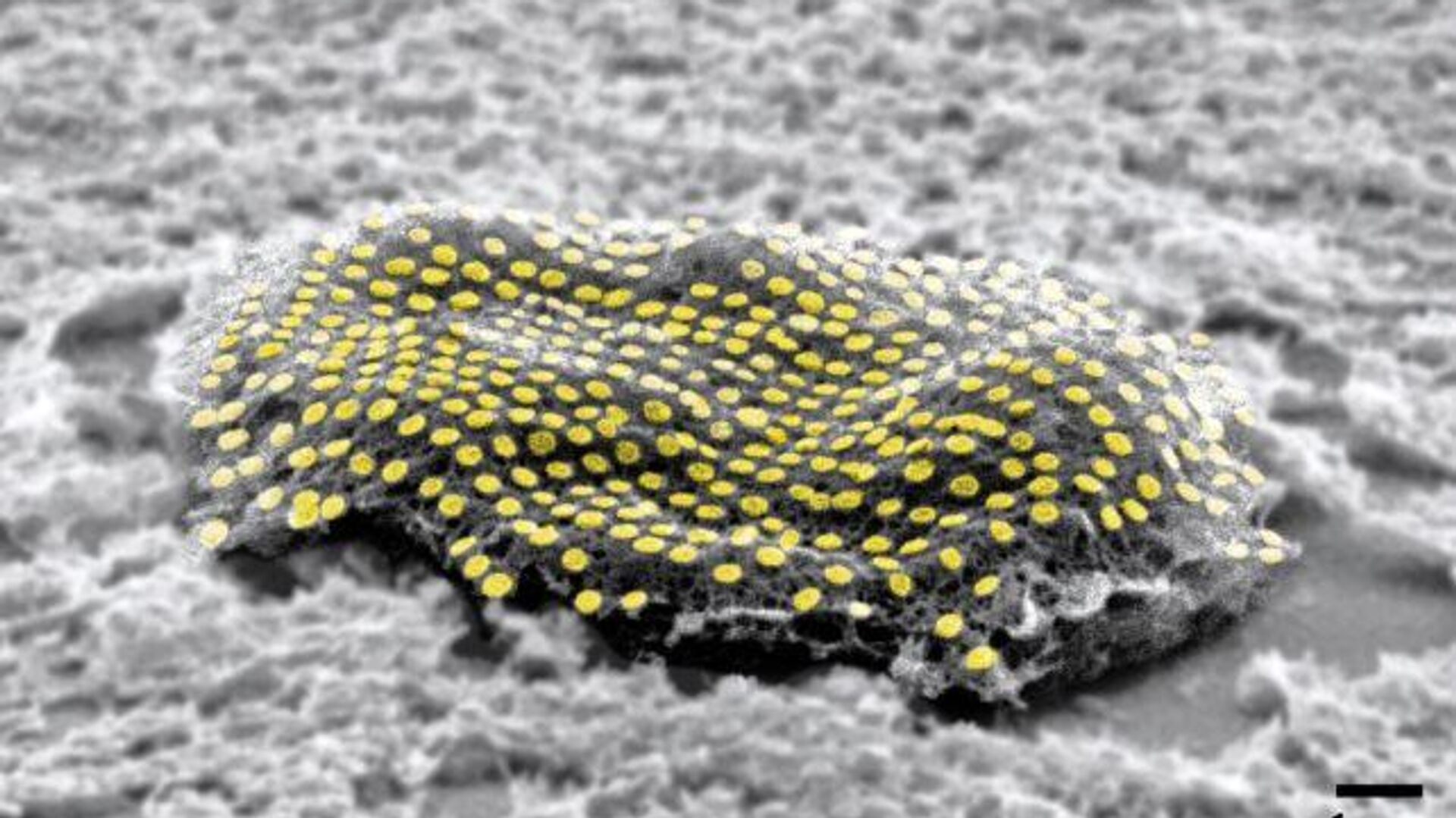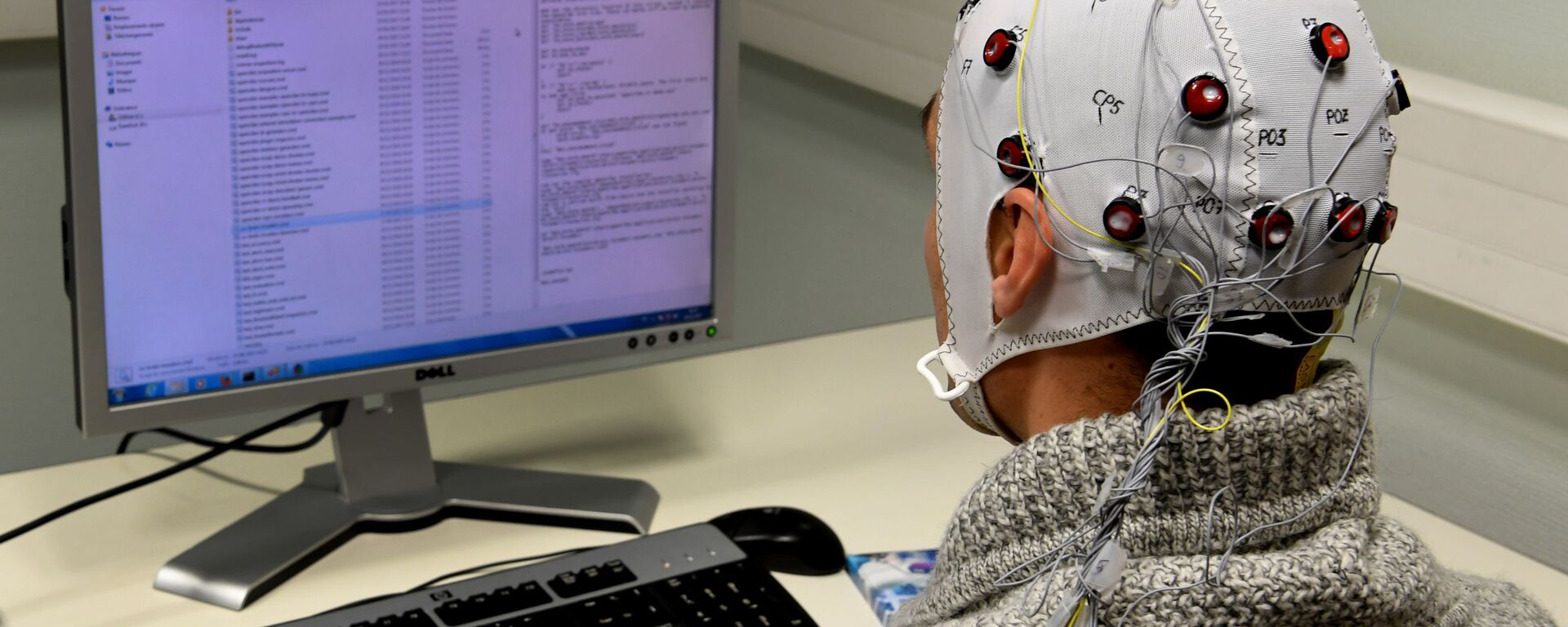https://sputnikglobe.com/20230827/cyberpunk-future-nears-as-scientists-find-way-to-fuse-nanocircuits-onto-living-tissue-1112933742.html
Cyberpunk Future Nears as Scientists Find Way to Fuse Nanocircuits Onto Living Tissue
Cyberpunk Future Nears as Scientists Find Way to Fuse Nanocircuits Onto Living Tissue
Sputnik International
Scientists have spent decades contemplating and working on neurotechnologies and nanoelectronics to ‘enhance’ animal or human brains and bodies using electronic devices. But until very recently, such ideas have remained the stuff of science fiction (and mostly dystopian science fiction at that).
2023-08-27T18:55+0000
2023-08-27T18:55+0000
2023-08-27T19:08+0000
beyond politics
johns hopkins university
american chemical society
national science foundation
science & tech
enhanced capabilities
neuro-interface
neurons
neuroscience
neuroscience
https://cdn1.img.sputnikglobe.com/img/07e7/08/1b/1112934004_0:30:642:391_1920x0_80_0_0_cd3e5fa1dda8169a111fc1348dbe45f8.jpg
A team of researchers from Johns Hopkins University has reported a major breakthrough in a technology which can one day be used to integrate individual human cells with electronics, implanting a nanocircuit of tiny gold particles and wires onto living embryonic fibroblast cells (cells whose job it is to create and sustain tissue) of mice.The patterned printing of the impossibly tiny gold and nanowire ‘tattoos’, made possible thanks to advances in a technology known as nanoimprint lithography, are seen as a first step toward remote, electronics-assisted monitoring and control of cells, all in real time.The micro-tattoos are envisioned as a non-invasive, non-toxic biosensor, with functionality similar to that of a barcode or QR code, researchers behind the technology say."We're talking about putting something like an electronic tattoo on a living object tens of times smaller than the head of a pin. It's the first step toward attaching sensors and electronics on live cells," he said."If we had technologies to track the health of isolated cells, we could maybe diagnose and treat diseases much earlier and not wait until the entire organ is damaged," Gracias added.The process of transferring the gold-nanowire pattern onto living tissue was a complex one, with Gracias et al.'s work involved treating the nanocircuit arrays with molecular glues and transferring them onto fibroblast cells using an alginate hydrogel film, which was then dissolved as the gold particles latched on to the cells. Researchers found that the man-made structures could stick to the cells for up to 16 hours, even as they moved around.Gracias hailed his team’s work as a major success. “We’ve shown we can attach complex nanopatterns to living cells, while ensuring that the cell doesn’t die. It’s a very important result that the cells can live and move with the tattoos because there’s often a significant incompatibility between living cells and the methods engineers use to fabricate electronics,” he explained.The Johns Hopkins’ research team plans to continue its research, and to attempt experiments on different types of cells and involving more complex nanocircuits.One Nanoparticle-sized Step Toward Cyberpunk Dystopia?Gracias et al.’s research, published in the August issue of NANO Letters, a monthly peer-reviewed scientific journal published by the American Chemical Society, received support from JHU, the National Science Foundation, the National Institutes of Health and the US Air Force Office of Scientific Research.While the scientists focused on the potential health benefits of the technology, they did not delve into mentioning its possible risks –including use by governments or large companies to monitor or control animals or people. Technology aimed at melding and manipulating tissue (including brain tissue) to control the behavior of living things has been secretly tinkered with by the CIA going back to at least the 1950s and 60s. More recently, primitive electronic-brain interfaces have been touted publicly as a tool for improved "workplace efficiency" at this year’s World Economic Forum gathering.The dangers of electronics-based human enhancement has also been explored at length by science fiction novels, serials and movies, from Neuromancer and Blade Runner to Ghost in the Shell and Black Mirror.
https://sputnikglobe.com/20230819/ai-pushing-boundaries-on-journey-to-mass-mind-reading-1112728932.html
https://sputnikglobe.com/20190606/darpa-to-develop-tech-for-tapping-into-human-brain-mind-controlling-drones-1075686098.html
Sputnik International
feedback@sputniknews.com
+74956456601
MIA „Rossiya Segodnya“
2023
News
en_EN
Sputnik International
feedback@sputniknews.com
+74956456601
MIA „Rossiya Segodnya“
Sputnik International
feedback@sputniknews.com
+74956456601
MIA „Rossiya Segodnya“
neuroscience, technology, nanocircuit, science, cyberpunk
neuroscience, technology, nanocircuit, science, cyberpunk
Cyberpunk Future Nears as Scientists Find Way to Fuse Nanocircuits Onto Living Tissue
18:55 GMT 27.08.2023 (Updated: 19:08 GMT 27.08.2023) Scientists have spent decades contemplating and working on neurotechnologies and nanoelectronics to ‘enhance’ animal or human brains and bodies using electronic devices. But until very recently, such ideas have remained the stuff of science fiction (and mostly dystopian science fiction at that).
A team of researchers from Johns Hopkins University has reported a major breakthrough in a technology which can one day be used to integrate individual human cells with electronics, implanting a nanocircuit of tiny gold particles and wires onto living embryonic fibroblast cells (cells whose job it is to create and sustain tissue) of mice.
The patterned printing of the impossibly tiny gold and nanowire ‘tattoos’, made possible thanks to advances in a technology known as nanoimprint lithography, are seen as a first step toward remote, electronics-assisted monitoring and control of cells, all in real time.
The micro-tattoos are envisioned as a non-invasive, non-toxic biosensor, with functionality similar to that of a barcode or QR code, researchers behind the technology say.
"If you imagine where this is all going in the future, we would like to have sensors to remotely monitor and control the state of individual cells and the environment surrounding those cells in real time," lead researcher David Gracias, a professor at the department of chemical and biomolecular engineering at Johns Hopkins' Whiting School of Engineering, said in a university press release.
"We're talking about putting something like an electronic tattoo on a living object tens of times smaller than the head of a pin. It's the first step toward attaching sensors and electronics on live cells," he said.
"If we had technologies to track the health of isolated cells, we could maybe diagnose and treat diseases much earlier and not wait until the entire organ is damaged," Gracias added.
The process of transferring the gold-nanowire pattern onto living tissue was a complex one, with Gracias et al.'s work involved treating the nanocircuit arrays with molecular glues and transferring them onto fibroblast cells using an alginate hydrogel film, which was then dissolved as the gold particles latched on to the cells. Researchers found that the man-made structures could stick to the cells for up to 16 hours, even as they moved around.
Gracias hailed his team’s work as a major success. “We’ve shown we can attach complex nanopatterns to living cells, while ensuring that the cell doesn’t die. It’s a very important result that the cells can live and move with the tattoos because there’s often a significant incompatibility between living cells and the methods engineers use to fabricate electronics,” he explained.
The Johns Hopkins’ research team plans to continue its research, and to attempt experiments on different types of cells and involving more complex nanocircuits.

19 August 2023, 15:21 GMT
One Nanoparticle-sized Step Toward Cyberpunk Dystopia?
Gracias et al.’s research, published in the August issue of
NANO Letters, a monthly peer-reviewed scientific journal published by the American Chemical Society, received support from JHU, the National Science Foundation, the National Institutes of Health and the US Air Force Office of Scientific Research.
While the scientists focused on the potential health benefits of the technology, they did not delve into mentioning its possible risks –including use by governments or large companies to monitor or control animals or people. Technology aimed at melding and manipulating tissue (including brain tissue) to control the behavior of living things has been secretly tinkered with by the CIA
going back to at least the 1950s and 60s. More recently, primitive electronic-brain interfaces have been touted publicly as a tool for improved "
workplace efficiency" at this year’s World Economic Forum gathering.
The dangers of electronics-based human enhancement has also been explored at length by science fiction novels, serials and movies, from Neuromancer and Blade Runner to Ghost in the Shell and Black Mirror.





